Minimonkey TWIN - The ergonomic twin carrier

The twin baby carrier
The Minimonkey TWIN equals the ergonomic carrying way of a traditional wrap, wins on comfort, user friendliness and safety!
This carrier can be used as of newborn (± 3kg ~ 6.5 lbs) to 12kg (~26.5 lbs) each baby.
Babies are carried in this baby carrier in an upright position on your belly, with the bottom low and thighs higher and spread wide; also referred to as the M-Position or Frog Position. Experts recommend this ergonomic position for carrying babies because it can have a positive effect on the development of their hips. The Minimonkey TWIN is a ‘hip-healthy product’, certified by the International Hip Dysplasia Institute.
Order NowComfortable, user friendly and safe
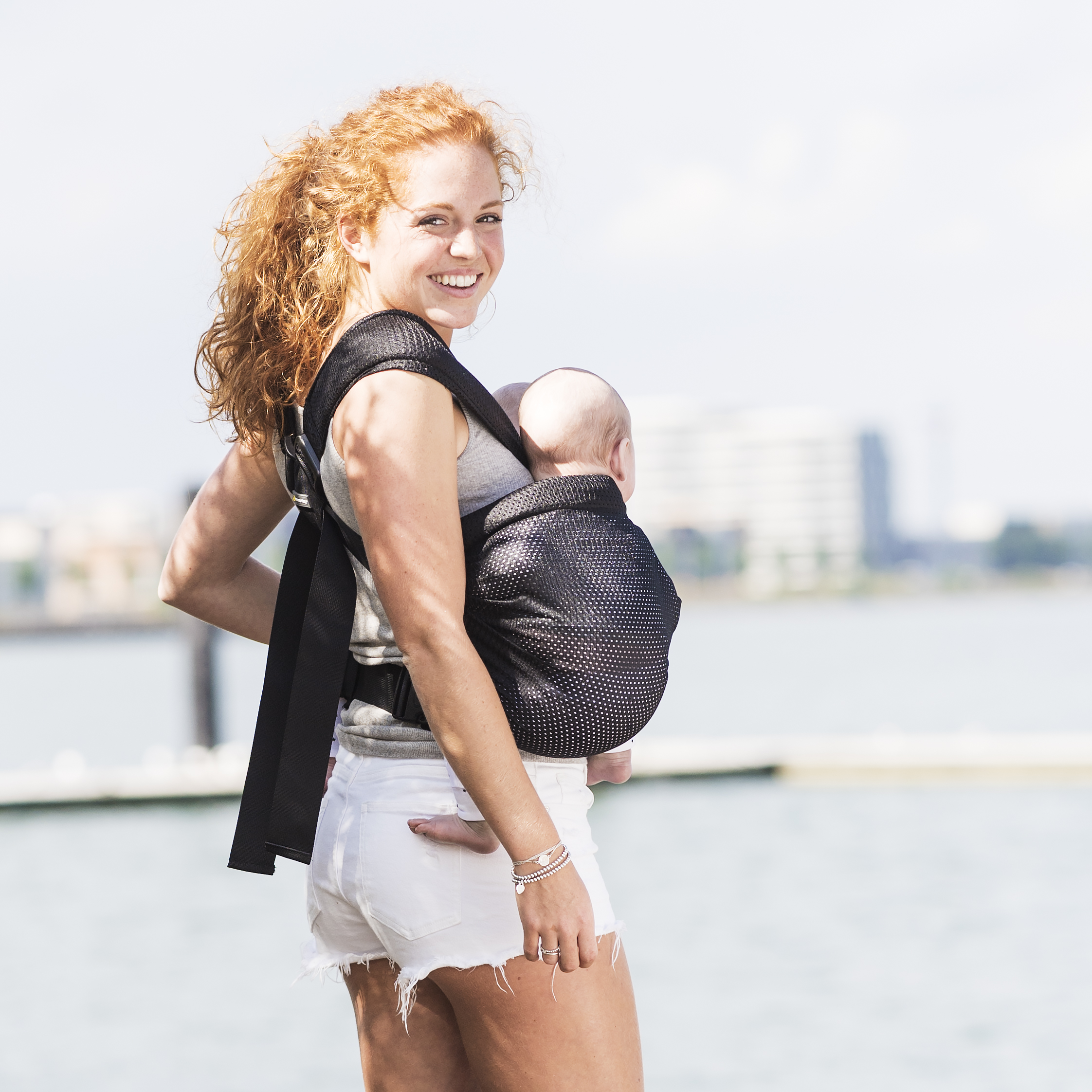
Twin carrier - mesh
NEW DESIGN – The twin carrier is now also available in mesh, the Twin Carrier – Mesh. Besides the fact that this new version of the twin carrier is made totally out of the airy mesh fabric, just like our Mini Sling, the design of the twin carrier has also been improved. This mesh version has a better fit than the cotton version, which gives the babies (also the very tiny ones) a better support and there is more room for the legs. In addition, also the straps are easier to adjust when the babies are positioned in the carrier.
SUMMER AND WINTER – You can use the mesh version of the Twin Carrier both in winter and in summer. Just make sure that your twins are dressed warmly when it is cold outside ⛄️
Order Now
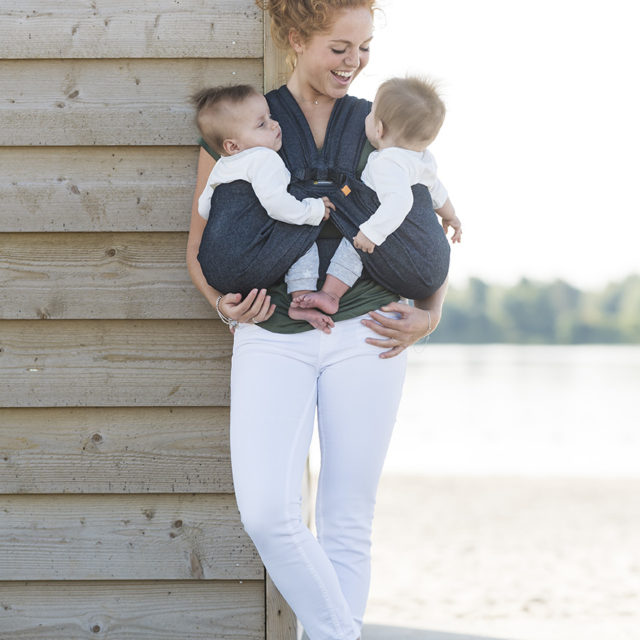

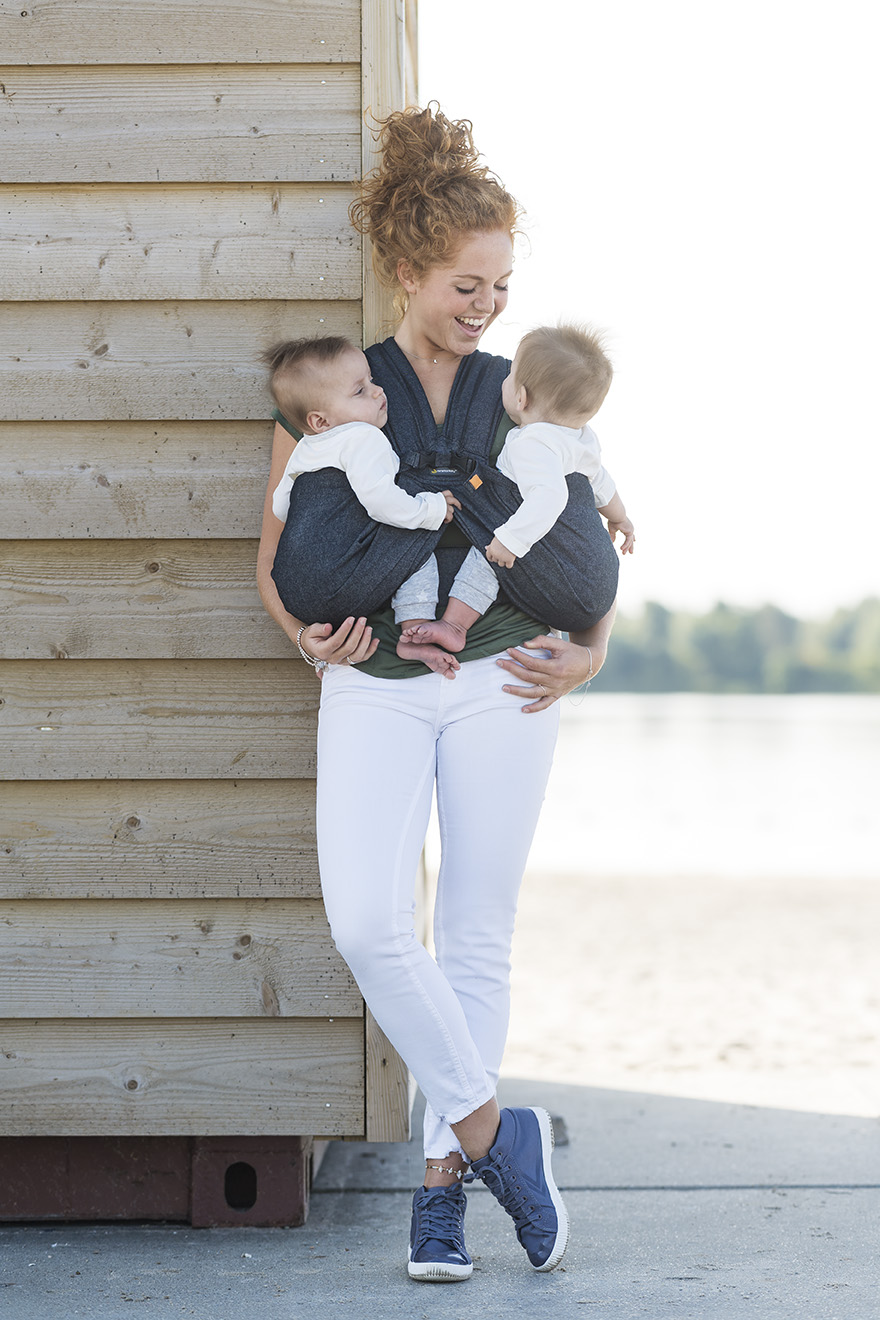
The comfortable twin carrier
If you search the internet you will probably learn that the most ergonomic way of carrying your baby is to carry your baby in a wrap. In a wrap the baby can be carried in the ergonomic M-position and the weight is divided over your whole upper body. Comfortable for you and good for your baby.
But what about carrying twins? Is carrying your twins in a wrap also possible? Yes it is, however it needs a lot of practice, skills and for most people it is simply too complicated.
In the last couple of years, I was contacted by many parents whether I had an easy and comfortable solution for carrying their twins (from newborn), because it simply didn’t exist. This is where the puzzle started. I challenged myself to create (together with babywearing consulants and parents) a twin carrier that was:
Comfortable – the wide shoulder straps in combination with the waistband divides the weight of the babies over your whole upper body. This makes it surprisingly light to carry.
Suitable for both newborn and older babies (max 12kg each baby).
Ergonomic – babies can be carried in the M-Position with the neck and back fully supported, comparable to the carrying way of a wrap.
Easy to use – intuitive to use and not many instructions to follow. After adjusting the carrier in the right size, the babies are placed in the pouches and tightened with a small buckle. You can do this by yourself. The carrier is designed as simple as possible to ensure the product self-explanatory.
Safe – the waistband prevents the baby from slipping out of the carrier.
This is for all the young parents out there who had to become ‘mulitaskers’ overnight…
❤️ Margot Visser (founder Minimonkey, Amsterdam)
Order Now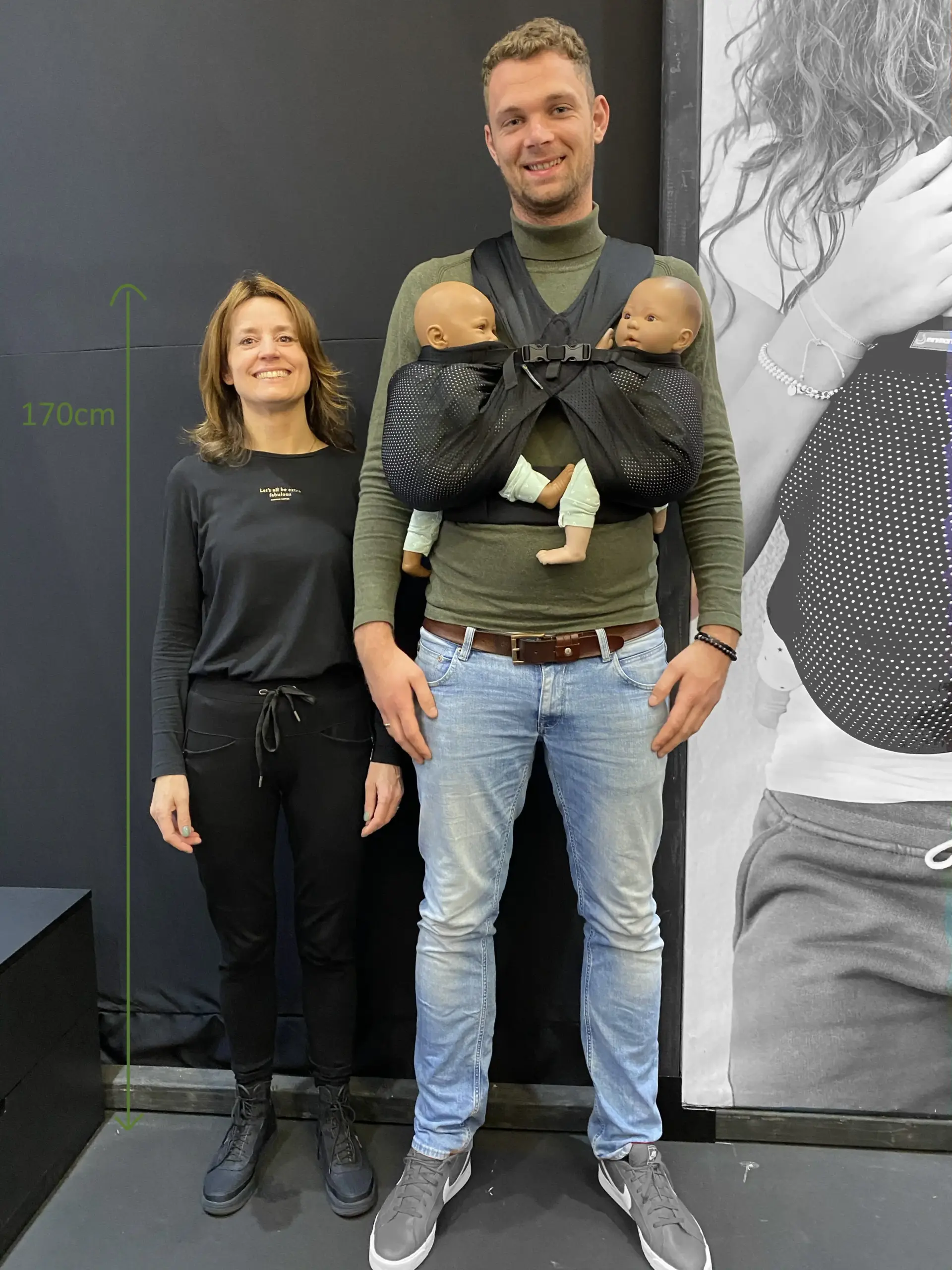
Suitable for XS - XXXL
The Twin Carrier is designed for both people with a smaller size (XS) and Plus Size users.
The waistband, which is worn high (just below the bust), has a length of approximately 129 cm, which is about 50,8 inch. For those with a larger waist circumference, an extension piece is available.

Instruction video
This is how you use the TWIN carrier
TIPS
The best 11 tips for using the TWIN carrier
-
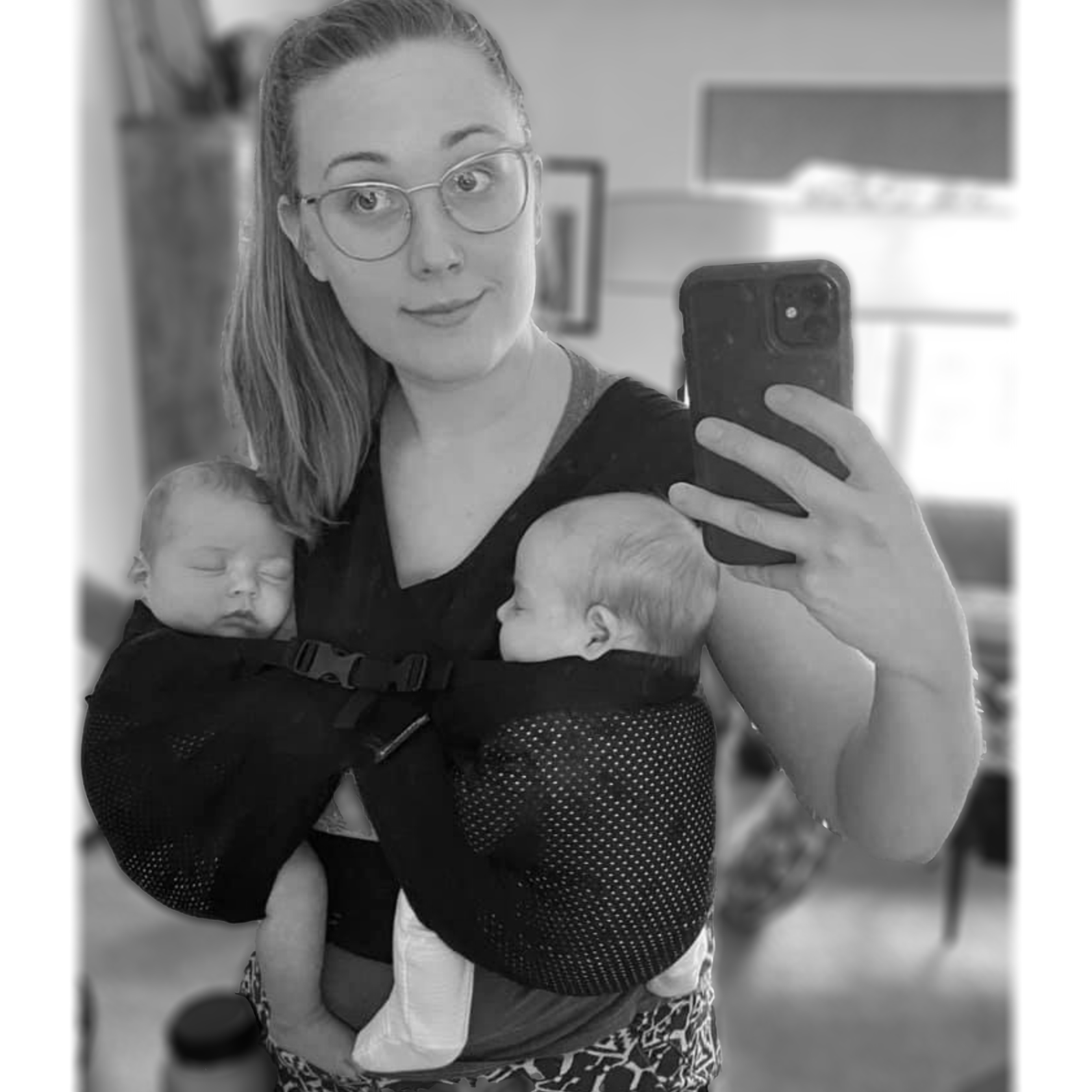 Tip 1
Tip 1Provide adequate support
You can use the Twin carrier immediately after birth*. The baby will be sufficiently supported if he is effectively secured in the carrier and it will therefore not be necessary to also support your baby with your hand. A (newborn) baby can’t yet support his own head, which is why it’s important for both the head and the back to be fully supported by the carrier and that the fabric is folded tightly across the back. It’s also the intention for babies to be held in a nice M-position in the carrier.
If you feel like your baby isn’t quite supported enough yet and you are still supporting him with your hand(s) too, then the carrier isn’t yet correctly in place. You can resolve this by:
- Adjusting the carrier correctly (see tip 2).
- Wearing the waistband high (!) (see tip 3).
- Making sure you’re carrying your baby upright (see tip 4).
- Using a neck roll with newborn twins (see tip 5).
- Spreading the straps across your shoulders and upper arms (see tip 6).
- Making sure the baby is carried in the M-position (see tip 7).
* consult with the care provider in case of premature or dysmature babies
-
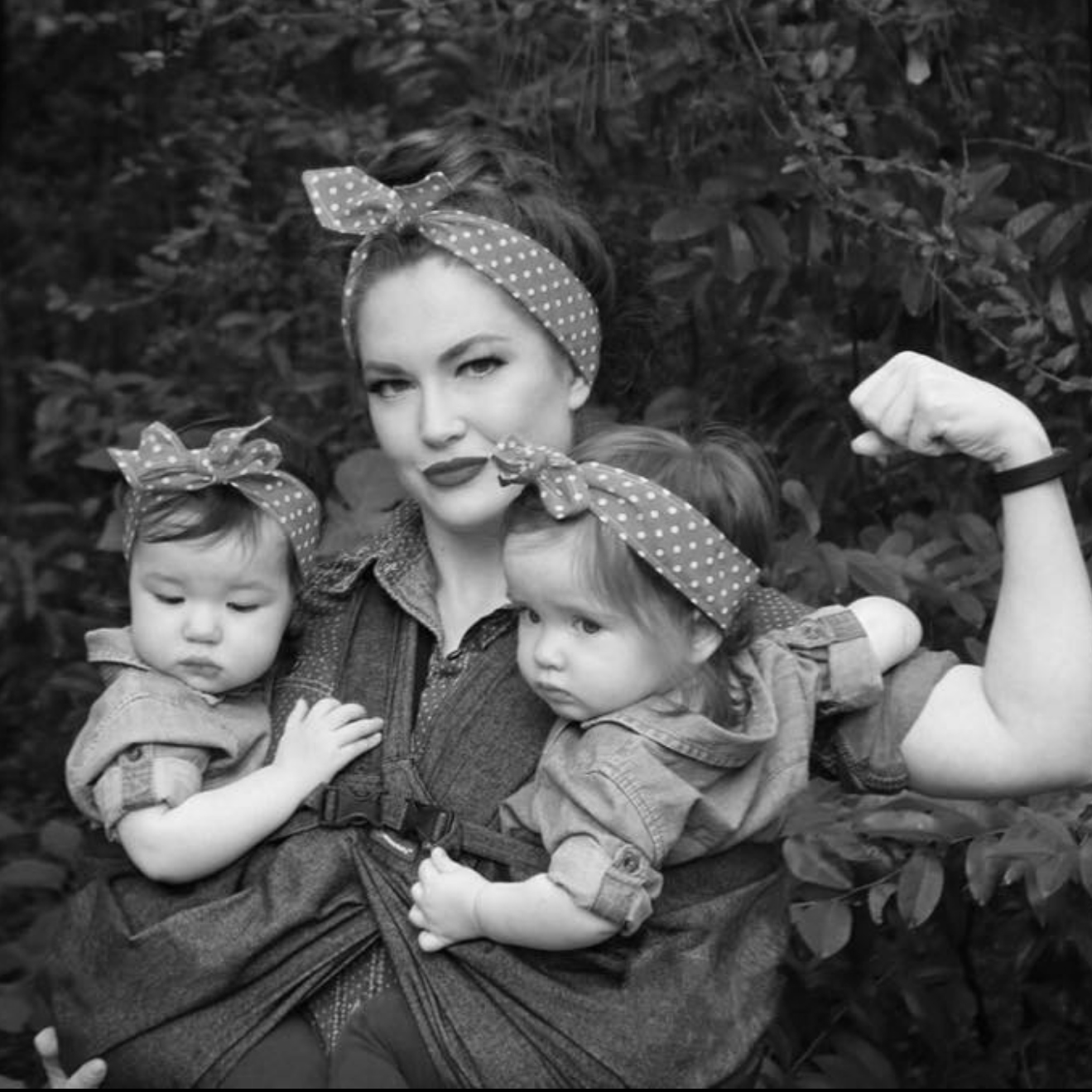 Tip 2
Tip 2Adjust the carrier properly
The Minimonkey twin carrier can be used from birth (±3kg ~ 6.5 lbs) up to 12 kg ~ 26.5 lbs (per baby). The better you adjust the carrier in line with your body, the more effectively the carrier will support your babies and the lighter the carrier will feel. How long you can actually continue using the carrier will differ per individual. One person will think newborn twins are heavy to carry and someone else can easily carry a couple of large toddlers. One thing which will definitely help to continue for as long as possible is to adjust the carrier properly.
We would recommend paying particular attention to the following when adjusting the carrier:
- Wear the waistband high (!) just under your breasts (see tip 3).
- Position the loops on the waistband right below and in line with the baby’s bottom and head (see tip 4).
- Tighten the shoulder straps on your back. You need to aim for the cross part on your back to be between your shoulder blades and the v on the front to be as far up as feels comfortable. Baby’s heads should be resting on the upper part of your chest. Baby’s heads should be close enough to kiss
- Make sure the two small clips on the front of the carrier are hanging at armpit height. When you close and tighten the clips on the front, the top edges of the pockets level with the wearer’s armpits. The top edge is now horizontal and the neck/head will be well supported.

-
 Tip 3
Tip 3Wear the waist band high (!)
Wear the waistband high (on your lower ribcage level) and tighten it so the weight is effectively distributed across your entire upper body and your shoulders are not bearing all the weight.
The waistband is often incorrectly referred to as a hip band, which results in people having the tendency to wear it too low. It’s really important to wear this band high around your waist (on your lower ribcage level). The pockets will then hang further over the band, making sure the babies end up in a good M-position, with their knees nice and high and the fabric stretched tightly across their backs. Many users even opt to wear the band just below the breasts, as is shown on this photograph.
-
 Tip 4
Tip 4Carry the babies upright in the carrier
The two carrying sections of the carrier are secured to the waistband with loops. The babies are intended to be carried upright in the carrier, with the loops, bottom and head all in a straight line.


If the baby’s head tends to ‘fall’ too much towards the armpit, this can be resolved by:
– wearing the small buckles at the front on armpit height (right image)
– tightening the shoulder straps
– wear the waistband high around your waist, just below the breasts
– sliding the loops over the waistband either to the front or to the side. You can slide the loops that attach the pouches to the waistband, across the waistband, making sure the loop is directly below the head and bottom. The perfect position of the loops/pouches depend on the size of the babies and your posture (play around to find it). The loops are secured quite tightly around the strap and they are easiest to move when you are not wearing the carrier. -
 Tip 5
Tip 5Use a neck roll
It’s important to make sure the fabric is folded tightly around the back and the head is optimally supported. It’s particularly important to prevent them slumping during those initial months, when the babies are still small and don’t yet have a good sitting balance.
Once you have positioned the baby in the carrier, you can pull the fabric up until this is tight around the back. Then roll up the top edge and only then close the clip. Any fabric which is still ‘loose’ on the sides can be folded away under the middle.

You can also use a neck roll – a small rolled up towel – to create even more support. This can be rolled into the top of the fabric.
-
 Tip 6
Tip 6Spread the shoulder piece
Your baby will sit higher up and more firmly against you if you spread out the straps across your shoulders and upper arms once the baby is in the carrier (!). This will also ensure the weight is more effectively distributed. Whether or not you like to spread your shoulders will differ per person. So this is simply a matter of trial and error…
You can easily spread out the shoulder strap by pushing the baby up by his bottom a little bit, whilst spreading the fabric across your shoulders at the same time.
The twin can also be used for (temporarily) carrying 1 baby, as shown on the photograph. Always make sure the shoulder piece is properly spread out across your shoulder and upper arm. This will ensure the baby is positioned more firmly against you and the shoulder strap won’t slide towards your neck.
-
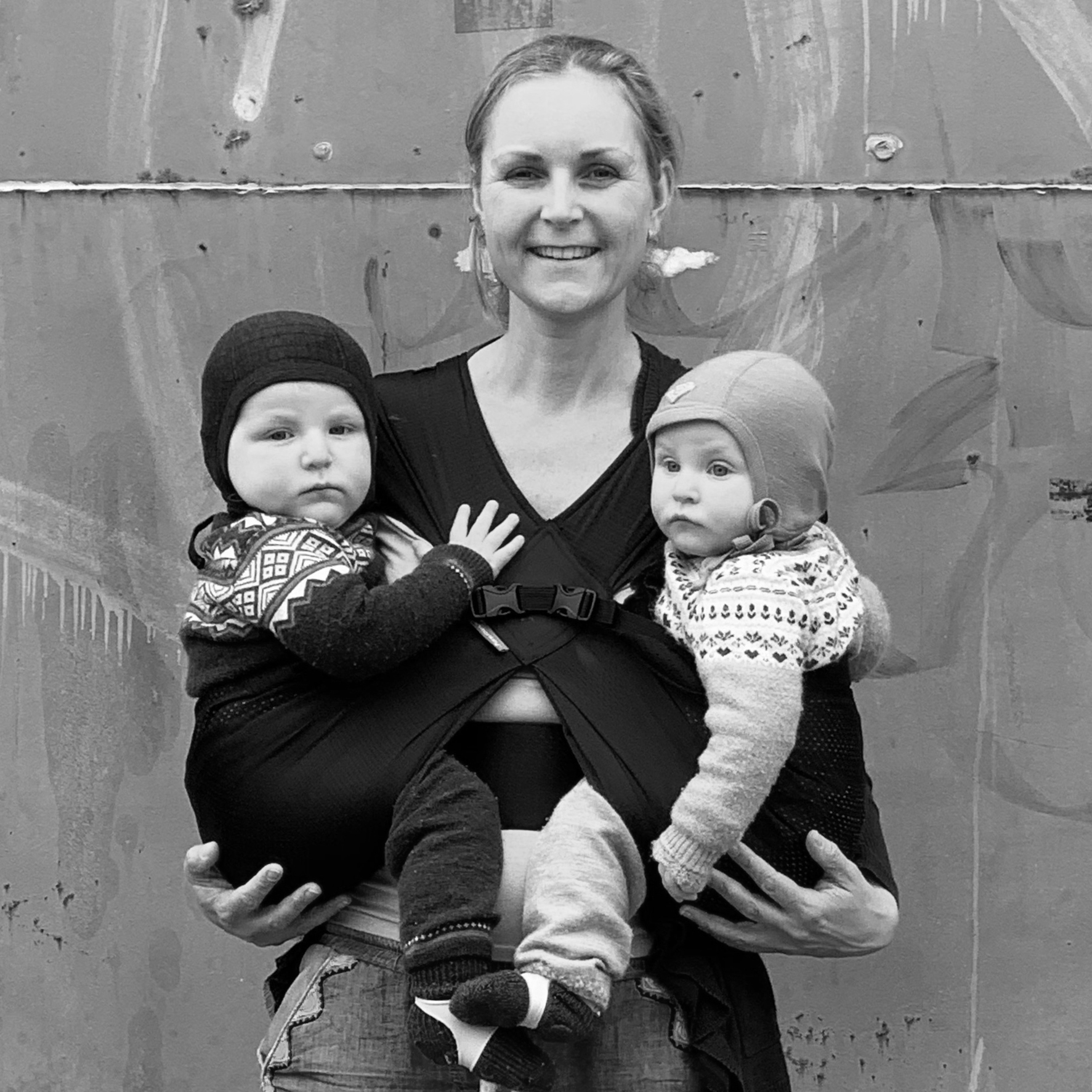 Tip 7
Tip 7Carry the babies in the M-position
We recommend carrying your baby ergonomically, in the so-called M-position, in order to ensure good development of the hips. This means the bottom is seated in the sling and the upper legs are supported. The bottom hangs lower than the upper legs.
Your baby may end up overstretching if he is not used to being carried in a carrier. This means he would be stretching his legs and back and will therefore ‘hang’ in the carrier, rather than taking on a relaxed ‘seated’ position with his bottom in the fabric. The fabric isn’t nice and tight around the back and bottom, which means the baby isn’t sufficiently supported. Fortunately this is easy to resolve by ensuring the waistband is worn high (see tip 1) and by ‘helping’ the baby a little bit:
-
- grab hold of the hollow of the knees and ‘turn’ them upwards towards you until the baby relaxes. You may need to repeat this step a few times before the baby really starts to relax.
- lift the baby up a little bit and pull the fabric underneath the bottom inwards and towards the hollow of the knees. The upper legs are now completely supported by the fabric and the baby is ‘seated’ in the carrier.
The legs should also be positioned outside of the carrier with a newborn baby. The legs will still be positioned very close together at this stage. The older they are, the more they will be able to spread their legs.
-
-
 Tip 8
Tip 8Use the carrier to feed
The Twin carrier can be perfectly used to feed both babies at the same time. You just have to adjust the length of the shoulder straps to lower the babies and position them at the right height.
—–

—–
This image has been shared in the ‘Tandem Babywearing’ group on Facebook.
-
 Tip 9
Tip 9Adjust shoulder straps
You can adjust the shoulder straps (only mesh version) to 3 different sizes, XS, S and M-XXXL. before use. For the sizes M – XXXL you don’t have to adjust anything, but if you have a smaller size, you can adjust the strap as on the drawing below. What length is most comfortable for you, depends on the size of your babies and your posture. Which size is best for you is something you just have to test.
The shoulder straps should be tightened. You need to aim for the cross part on your back to be between your shoulder blades and the v on the front to be as far up as feels comfortable. Baby’s heads should be resting on the upper part of your chest. Baby’s heads should be close enough to kiss.

-
 Tip 10
Tip 10Loading order ??
Always load the heavier baby in on the non dominant side first.
-
 Tip 11
Tip 11Use in cold weather
If you use the twin carrier in cold weather, we advise to dress the babies in snow suits. If it is extremely cold, also wrap a blanket around or use a ‘cape’ like on the picture.
???? ❤️ ??? Pearl Ball-Harding
From birth to 12kg ??









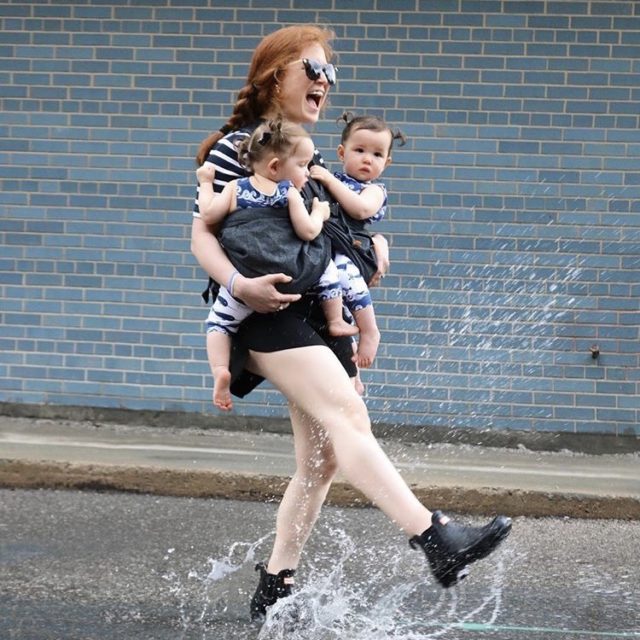










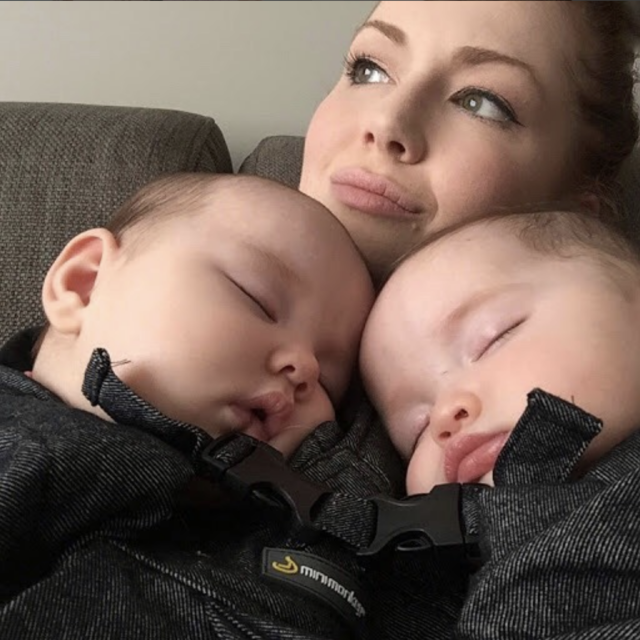



Specifications
- Weight:
- 0.58 kg
- Dimensions:
- 16 x 12 x 26 cm
- Material:
- Mesh & cotton
- Download:
- Instruction and safety advice

